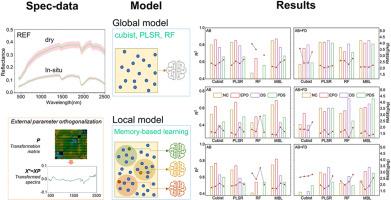In-situ prediction of soil organic carbon contents in wheat-rice rotation fields via visible near-infrared spectroscopy
引用次数: 0
Abstract
Visible near-infrared (VNIR) spectroscopy is a reliable method for estimating soil properties. However, its effectiveness in accurately predicting soil organic carbon (SOC) contents, particularly in wheat-rice rotation fields, remains uncertain. In this study, we collected 202 samples from wheat-rice fields (0–20 cm) in southeastern China and measured in-situ spectra of the vertical surface of the soil cores and the laboratory spectra of the dried and sieved soil samples. Our study focused on evaluating three algorithms - external parameter orthogonalization (EPO), direct standardization (DS), and piecewise direct standardization (PDS) - to address the influence of external factors, particularly soil moisture. To carry out our analysis, the dataset was divided into calibration (141 samples) and validation (61 samples) sets via the Kennard-Stone algorithm. A subset of the corresponding in-situ and laboratory spectra in the calibration set (transfer set) was used to derive the transfer matrix for EPO, DS, and PDS, enabling the conversion of in-situ spectra to laboratory spectra by characterizing their differences. Four machine learning models, including cubist, partial least squares regression (PLSR), random forest (RF), and memory-based learning (MBL), were used to predict the SOC, particulate organic carbon (POC), and mineral-associated organic carbon (MAOC) contents based on the laboratory, in-situ, and corrected in-situ spectra. The results revealed that the laboratory spectra outperformed the non-corrected in-situ spectra, with coefficients of determination (R2) of 0.91, 0.75, and 0.80 for SOC, POC, and MAOC, respectively. Among the models, MBL and PLSR exhibited the highest average R2 at 0.85–0.86. EPO marginally improved the prediction accuracy (R2 increased from 0.85 to 0.87 for SOC, 0.64 to 0.69 for POC, and 0.75 to 0.82 for MAOC). These promising prediction accuracies underscore the potential of VNIR spectra for in-situ predictions in wheat-rice fields in Southeast China, offering insights for predicting SOC contents via in-situ spectroscopy.

通过可见近红外光谱原位预测小麦-水稻轮作田土壤有机碳含量
可见光近红外(VNIR)光谱法是一种估算土壤特性的可靠方法。然而,它在准确预测土壤有机碳(SOC)含量,尤其是小麦-水稻轮作田土壤有机碳含量方面的有效性仍不确定。在本研究中,我们从中国东南部的小麦-水稻田中采集了 202 个样本(0-20 厘米),并测量了土壤核心垂直表面的原位光谱以及干燥和过筛土壤样本的实验室光谱。我们的研究重点是评估三种算法--外部参数正交化(EPO)、直接标准化(DS)和片断直接标准化(PDS)--以解决外部因素(尤其是土壤湿度)的影响。为了进行分析,我们通过 Kennard-Stone 算法将数据集分为校准集(141 个样本)和验证集(61 个样本)。校准集(转移集)中相应的原位光谱和实验室光谱的子集用于推导 EPO、DS 和 PDS 的转移矩阵,通过表征它们之间的差异将原位光谱转换为实验室光谱。利用立方体、偏最小二乘回归(PLSR)、随机森林(RF)和基于记忆的学习(MBL)等四种机器学习模型,根据实验室光谱、原位光谱和校正后的原位光谱预测 SOC、颗粒有机碳(POC)和矿质相关有机碳(MAOC)的含量。结果显示,实验室光谱优于未经校正的原位光谱,SOC、POC 和 MAOC 的判定系数 (R2) 分别为 0.91、0.75 和 0.80。在这些模型中,MBL 和 PLSR 的平均 R2 最高,为 0.85-0.86。EPO 稍微提高了预测准确度(SOC 的 R2 从 0.85 提高到 0.87,POC 的 R2 从 0.64 提高到 0.69,MAOC 的 R2 从 0.75 提高到 0.82)。这些良好的预测准确性凸显了近红外光谱在中国东南部小麦-水稻田原位预测中的潜力,为通过原位光谱预测 SOC 含量提供了启示。
本文章由计算机程序翻译,如有差异,请以英文原文为准。
求助全文
约1分钟内获得全文
求助全文

 求助内容:
求助内容: 应助结果提醒方式:
应助结果提醒方式:


